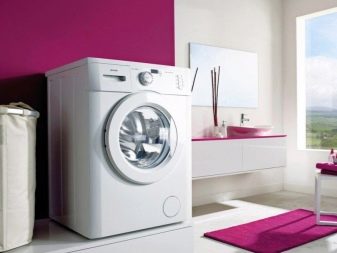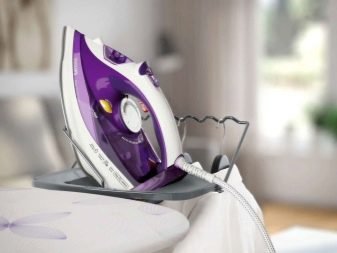Everything You Need to Know About Cloth Napkins

Cloth serving napkins are an important part of table linen. From the material in this article, you will learn what are their pros and cons, varieties, design options and folding. In addition, we will show you what to look for when choosing them and what are the nuances of care.
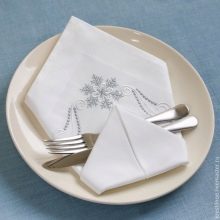

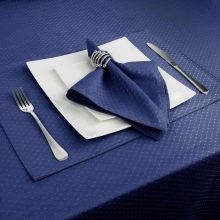
Advantages and disadvantages
Serving cloths have a number of advantages.
- They have a decorative and practical function. They decorate the dining table, emphasize the special atmosphere, turning the feast into a celebration. They make the table setting more original, preventing damage to the table top and the tablecloth used.
- Napkins can be of different sizes (30x30, 40x40, 50x50 cm)... They are often supplied complete with a tablecloth. They are carried out in the same style and color scheme with it.
- Serving napkins are on sale in a wide range. They are used not only at home, but also in catering places (cafes, restaurants).
- Products can have a different type of weaving of threads (plain, twill, matting). This determines a different type of density, deformation and tear resistance.
- They are often treated with a water-repellent impregnation. Thanks to this, they are easy to clean. They can have a wide variety of folding patterns. They do not provoke allergies, are strong, durable.
- They are characterized by environmental friendliness, durability. Some absorb moisture and have bactericidal properties. They are distinguished by pleasant tactile sensations.
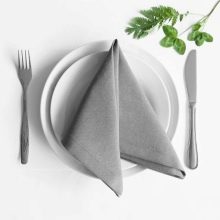
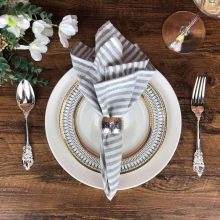

Along with this, the products have several disadvantages. Strong tea stains cannot be removed from the surface of some.Others are bad because they wrinkle a lot. Not all types of fabrics are suitable for washing at maximum speed in the machine.
Description of species
Textile napkins can be classified according to different criteria. For example, according to the type of texture, they are smooth and terry. Variants of the second group are more durable, but they are used less often.
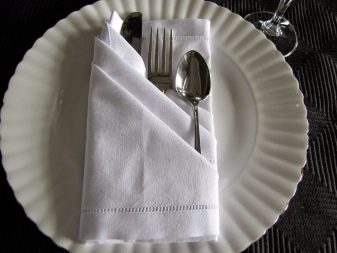
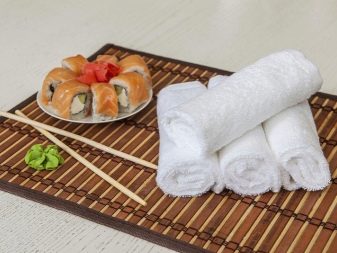
By the type of manufacture, the varieties are single and double. Double models are more robust and durable.
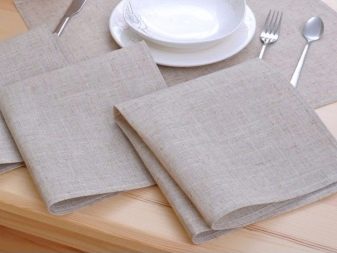

In addition, napkins differ in the material of manufacture. Each type of product has its own characteristics.
Cotton
Cotton dining models have a plain weave of threads, depending on their thickness, they differ in density (coarse calico is the most dense, satin and poplin are thinner). Differ optimal strength, hygroscopicity, softness.
They are environmentally friendly, visually attractive, give a slight shrinkage during washing. Moderately crumple, often fade after the first wash. Machine washable.

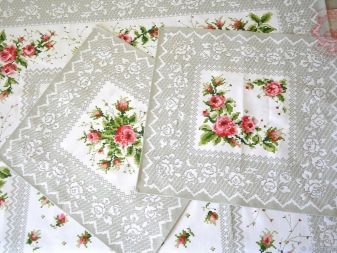
Linen
These varieties are used for table setting more often than others. Linen has a plain weave, like cotton, it is highly breathable and warm. Differs in special aesthetics and naturalness.
Easy to wash, not deformed, is a practical and durable material. These wipes are antiseptic, but easily wrinkled. They lose strength from frequent washings.

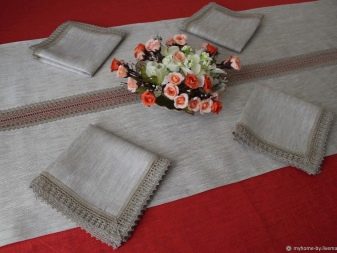
Polyester
Synthetic wipes are easy to clean and durable. They do not shrink during washing, perfectly repel moisture, grease, and are resistant to creasing and shedding.
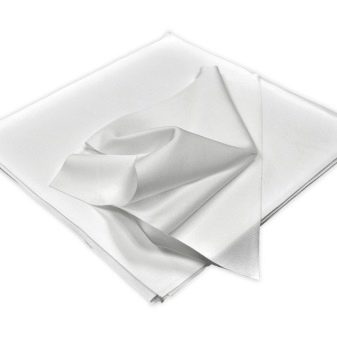
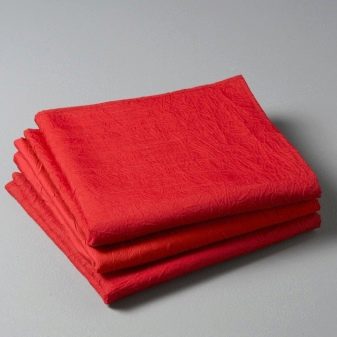
Bamboo fiber
These modifications have unique properties. They resemble cashmere to the touch, absorb moisture well, and are anti-allergenic. They contain bamboo jade, thanks to which they perfectly absorb fat.
Regardless of the amount of dirt, they can be perfectly washed with ordinary running water. No ironing required, machine washable. However, vulnerable to drying on a heater or radiator.
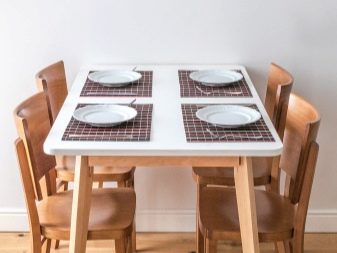
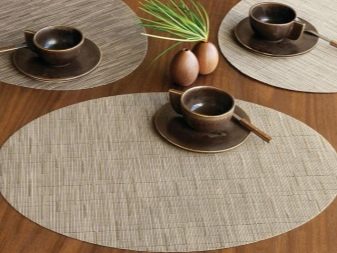
Mixed fabrics
Often, to improve the quality of materials, other fibers are added to natural threads. For example, linen is mixed with viscose, wool, cotton. They have a smooth surface and a matte texture type.
Products made from mixed raw materials are considered practical and inexpensive. At the same time, the percentage of input components may vary. This reduces the shrinkage of the fibers after washing and increases the wear resistance of the wipes.
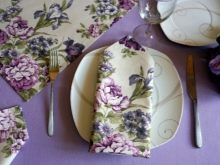
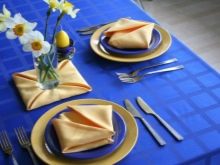
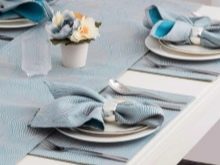
Polyester threads are often added to cotton. Thanks to this, the napkins not only allow air to pass through well, but dry faster, wrinkle less, and become more resistant to stains and ultraviolet rays.
In addition, other materials are used in the production of napkins (gabardine, polyoxford, wet silk, advertu, atlas).



Design options
Design solutions for table napkins can be laconic and elegant.
- Classic models are made in one color. They have no decorative elements and have a purely practical function. Usually these are white, beige accessories for frequent meals and family feasts. It can also be sandy gray linen napkins or brownish sandy bamboo napkins.

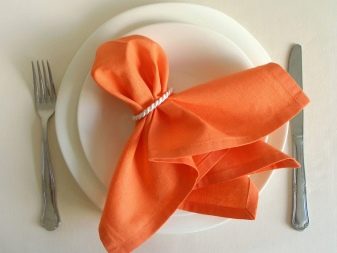
- Analogs for special celebrations are sewn with trimmed edges with various details. For example, New Year's themed napkins might have a green, red background and trim.
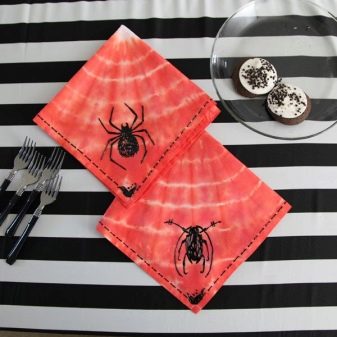

- Most often, the edge is trimmed with lace, braid. Linen varieties are decorated with hemstitch. Napkin prints can be classic or designer.
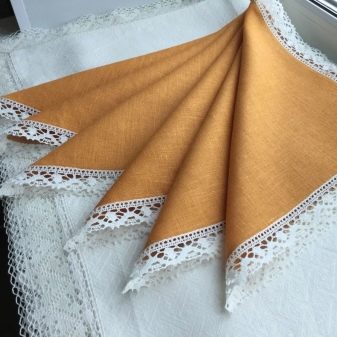
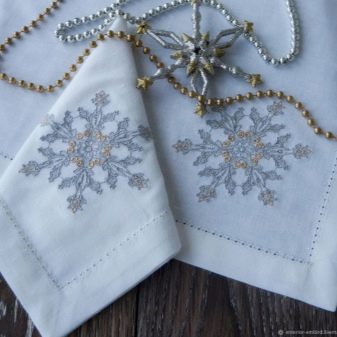
- Variants of the first group - a cage, a strip. Embroidered varieties are produced for restaurants. Most often these are laconic silk or other textile models of white, burgundy, brown, colors with a glossy texture and a discreet accent. Black napkins are also in vogue.
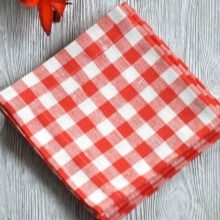
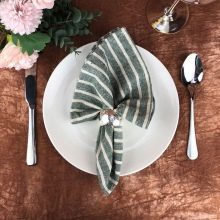
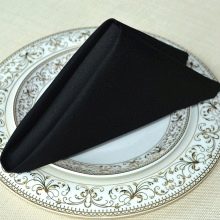
- Decorative napkins for the festive table can be made using the patchwork technique... In addition, today you can order models with prints on any topic.For example, accessories with plant, floral, ethnic motives are perfect for a cafe.
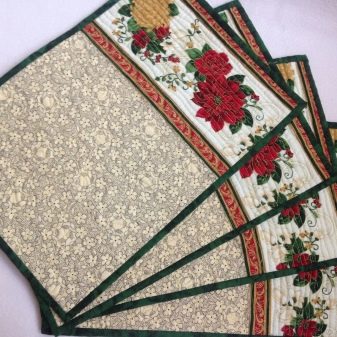
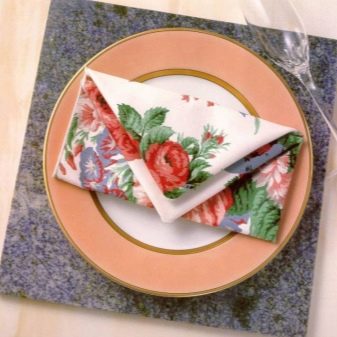
- Photo print design can be very diverse. At the request of the customer, the manufacturing company decorates the front side with any logo, pattern, emblem and even initials, photograph.
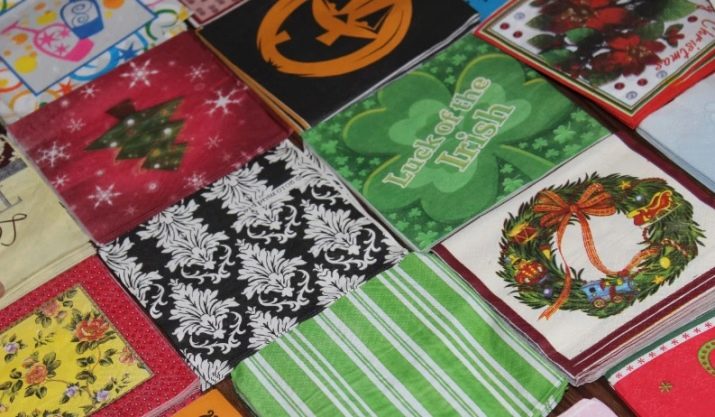
Optional accessories
Depending on the type of folding, various additional parts may be needed for the napkins. For example, the most popular of them are special metal rings, thin decorative ribbons, napkin holders.
In addition, for greater aesthetics, napkins are complemented with artificial and natural flowers and feathers. With their help, unique serving compositions are created.
All kinds of clamps are especially popular today.
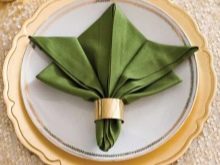
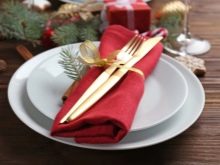
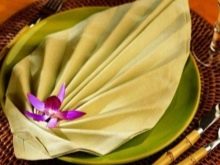
Selection Tips
Serving napkins for table decoration are chosen according to the fabric of the tablecloth. At the same time, its appearance and pattern are taken into account. Also one of the key purchase criteria is size. It is selected based on a specific folding pattern.
The density of the material also depends on this. For festive options, they take into account the theme of the holiday, their own taste preferences. Products are selected for the interior of a particular room.
It is important to choose the material that keeps its shape well after starching. It is advisable to choose double-sided options with a minimum thickness. It is easier to add complex shapes from them.
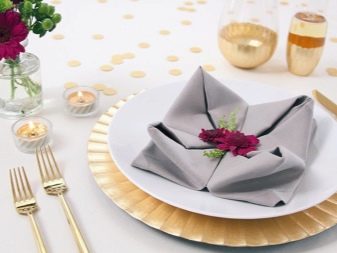
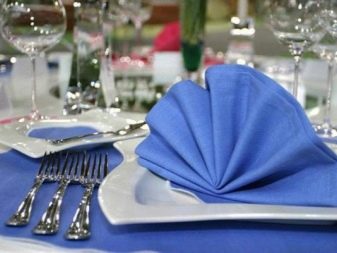
Folding methods
You can beautifully roll napkins for table setting according to different patterns. For example, a starched textile napkin can be folded like an accordion, folded in half and placed in a glass, straightening the upper edges of the resulting fan.
A small napkin can be folded diagonally and rolled into a metal ring. If there is no such accessory, you can tie the resulting tube with a beautiful decorative ribbon in the form of a bow.
Heavyweight napkins can be folded even more easily. It is enough to fold them 2 times diagonally, forming a small triangle. To prevent the napkin from straightening, you can put it on a plate, fixing it on top with an artificial flower.
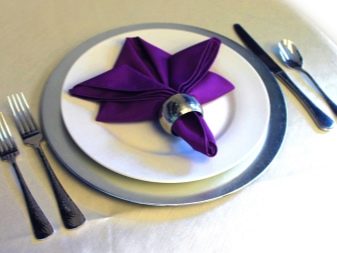
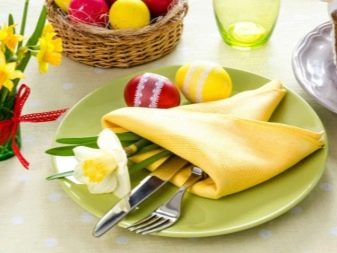
Let's consider some folding options.
Candle
To make such a design, you need to spread a thin napkin on the table. Then it is folded diagonally and a strip 2-3 cm wide is folded upwards from the bottom side.
The napkin is turned over and rolled tightly. The edge of the napkin is folded over the strip, thereby fixing the made candle. The structure is straightened and placed on a plate or tray.
Sometimes the candle is not rolled up diagonally. In this case, its wick is formed from the center by pulling the material over the edge and pulling it to the desired length.
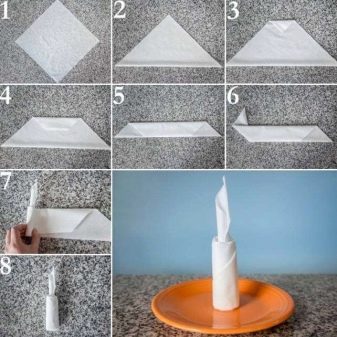
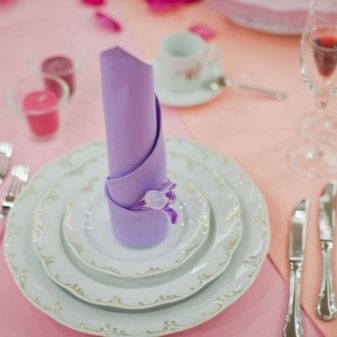
the Rose
To fold a napkin in the shape of a rose, it is laid out on the table at an angle to itself, forming a rhombus. After that, the upper edge is folded several times, moving downward, leaving a corner of 10 cm.
Then the future flower is folded from right to left. To prevent the structure from disintegrating, the edge is folded down and fixed in the layers of the twist. After that, 2 sheets are formed from an untouched corner, bending them in different directions.
The finished flower is placed on a flat plate.
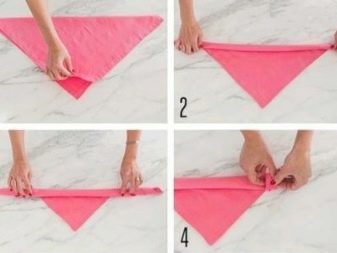
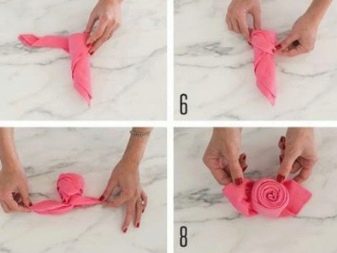
Flame
To roll a napkin into a tall tongue of flame, lay the napkin face down and fold it diagonally. Then, from the larger side, it is folded with an accordion to the very end. Fold in half, fix the upper edge with a buckle or a beautiful clip. The sides are straightened.
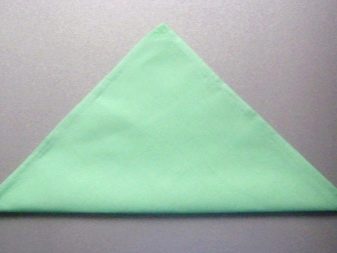
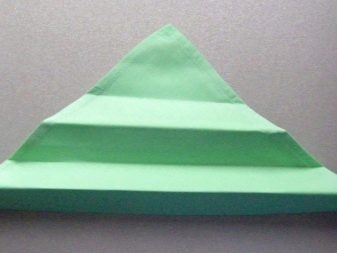

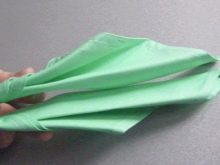
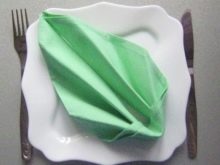
Fork and knife envelope
To make an envelope from a tissue napkin, you need to fold the napkin in half, then again, forming a small square. After that, the top layer is folded back, forming a triangle.
The layer under it is folded in the same way, but under the top layer so that it protrudes by about 1.5-2 cm. The third layer of the corner is folded in the same way, leaving 1.5-2 cm protruding above the second.
Then the napkin is turned over to the opposite side. Fold up to half on one and the other side. Flip over to the front side.They put a fork, knife, spoon in their pockets.

Fan with stand
The napkin is placed face up on the table, fanned out. They do it like this: start from the top, wrap the strip down, turn it over and assemble it according to the accordion principle.
After that, the assembled napkin is folded in half. To make a stand, the fan is squeezed in the hand and the inner fold is gently pulled out on both sides. The fan is fixed and straightened.
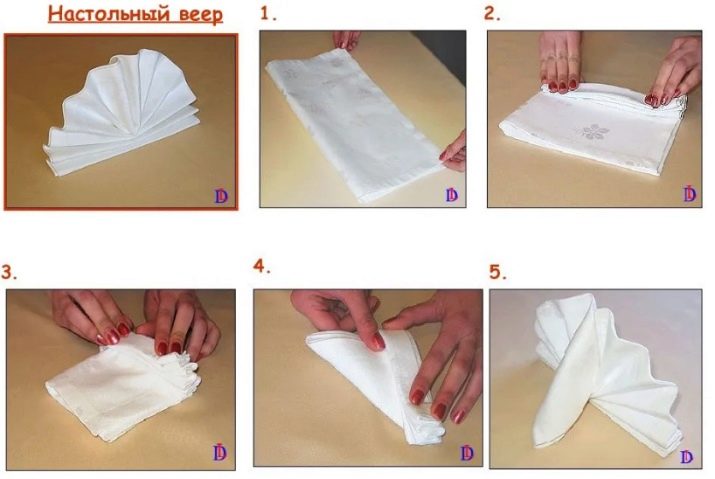
Care secrets
The care of your table napkins depends on the type of material.
- For example, flaxseed varieties can be boiledhowever, washing is often not recommended. The optimal washing mode is 60 degrees.
- If the napkins have decor, it is better to wash at a temperature of 40 degrees... The detergent should be universal, designed for thin materials without bleaching.
- Drying wipes must be natural, otherwise they will shrink... Ironing is carried out with moisture. Stains are removed using conventional means. Bamboo fiber napkins are washed in everyday life with ordinary laundry soap.
- Polyester garments are easy to care for. You need to wash in a delicate mode, iron at a low temperature. It is impossible to bleach accessories, it is better to dry naturally.
- Cotton napkins are washed at different temperatures (white - at 95, colored - at 40). Any detergent will work (except for colored detergents with bleach). You need to iron the napkin with moistening or steam.
